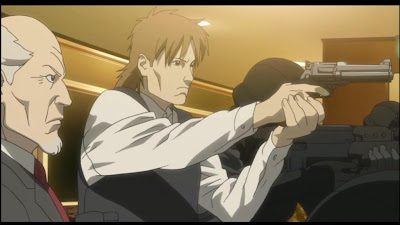
Looking back on the first series (1st Gig, I guess you could call it, although no-one really does), the recurring 'Laughing Man' storyline was several orders of magnitude better than the episodes which tried to shoehorn a single story into their twenty-five minute running time (often resorting to exposition and coincidence to do so). As a huge fan of Mamoru Oshii's 1995 Ghost in the Shell feature film, I would even say that the Laughing Man episodes can stand shoulder-to-shoulder with his work, even if they aren't quite up to the same standard. For this reason, 2nd Gig understandably focuses most of its episodes on a central mystery, and, less understandably, does pretty badly at it.
Writer-director Kenji Kamiyama apparently took this over-arching storyline as an excuse to ignore the individual worth of any single episode. Many episodes, rather than possessing any kind of climax or cliffhanger, instead finish with us being parcelled out some small nugget of information about the central mystery, or some mechanically plotted piece of foreshadowing. Some of the episodes consist almost entirely of exposition that could have easily been more interestingly or more succinctly presented. And, apparently unable to work the main characters of Security Section 9 into all the important events, Kamiyama instead has our heroes watch many of the most dramatic parts of the story on TV (I can, at least, identify with them quite well in this respect). Whenever Section 9 actually do seem to do something of worth, we're then treated to shadowy villain Gohda smiling evilly and remarking that they reacted exactly as he had planned them to. Rather than protagonists struggling against adversity, 2nd Gig all too often seems to be merely presenting us with a bunch of stuff that happens.

It's not all bad, of course. Thanks to the success of the first series, 2nd Gig has seriously ramped up the production values, constantly providing luscious, atmospheric visuals and smooth, dynamic movement. If I tend to be a little harsh on action films that fail to measure up, it's only because Stand Alone Complex has absolutely spoiled me rotten with its fluid, perfectly choreographed, perfectly framed, perfectly paced action scenes.
As with the first season, there are also those episodes that avoid the recurring storyline. And, in a complete reversal, these are the ones that stand out as particularly excellent. The problem of fitting a whole plot into twenty-five minutes has been solved by instead making these episodes simple vignettes that focus on a particular character. Motoko stumbles upon hidden memories from her childhood; taciturn Paz is stalked by a former lover who has stolen his appearance; mysterious Saito relates how he met Motoko and lost his eye (unsurprisingly in the same incident). These episodes are exciting, moving, atmospheric, occasionally even understated. I'd go so far as to say that the episode about Motoko's childhood is easily one of the most affecting pieces of animation I've seen.

The final three episodes, of course, do not include such a vignette. And if I was hoping that all the exposition and foreshadowing we were subjected to in previous episodes meant that we would now get a stonking, all-action, all-drama finale, I was also disappointed. Where these last three episodes do best is not in giving us relentless action or emotional development, but instead in reminding us of the nifty ideas and themes underlying the main storyline. Immigration, terrorism and democratic disaffection are all dealt with as part of a situation that develops as a direct allegory for Japan's (and many other nations', I would add) involvement in the Iraq war. At it's most obvious, we see a mostly civilian area being bombarded with shells and missiles before cutting to a television journalist calmly reporting the event to us as if it were all civilised and unavoidable.
Moments like this are what work best about the main storyline, especially with regard to prime anti-hero Hideo Kuze. The result of a mental computer virus designed to create 'heroes' - with the intention that they will actually be considered terrorists and unwittingly aid a sinister right-wing agenda – Kuze is apparently the one-in-a-million real hero: a man of enormous charisma who will fight when it is necessary but otherwise eschews violence. Of course, it's easy for Kuze to be sanguine, with his bulletproof, military-issue 'prosthetic body'. Many of the desperate, impoverished refugees who flock to him, however, are a little more jittery on the trigger, and the way that Kuze's almost romantic heroism is reinterpreted, misunderstood and twisted by his followers is another nifty part of the series. I'm reminded of the contrast between Jesus and many Christians. Kuze even acquires some stigmata when he's shot through the hand.
2nd Gig, while we're on the subject, is keen to try and achieve the weightiness of Oshii's feature film, heaping on the symbolism to little actual effect. At one point, Motoko hands Kuze an apple while her perennial admirer Batou tries to literally bash his way into the scene with a giant crucifix. Those who come to Stand Alone Complex seeking subtlety will leave quite empty handed.

Probably the best example of all the missed chances I saw in this show is the light suddenly cast on very minor character Proto. A delicate, reticent, slightly sad fellow with a quiet dedication, he's utterly unlike any of the other members of Section 9. Why then is such an interesting personality given only scant seconds of screen time before stepping forward in the final three episodes? And yet, I can't complain entirely, because he is an interesting character, and he is given some focus in these last episodes. As with everything else to do with Stand Alone Complex, it's a case of brilliant ideas with mixed execution.
1 comment:
I hadn't heard of this series before. Thanks for such a well-written review.
Hope you're feeling better now, Pacian!
Post a Comment